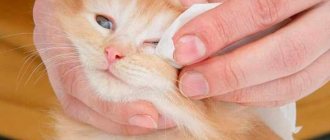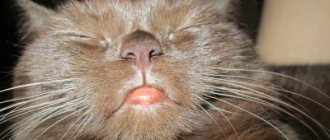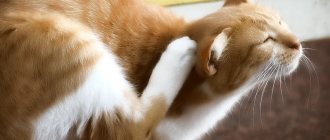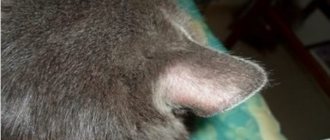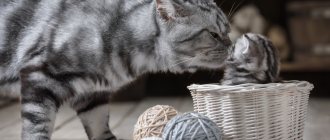7159Pavel
Unfortunately, cat breeders, even the most experienced of them, periodically face the negative consequences of communicating with their pets. Let's consider the question of what to do if a cat scratches its eye. In case of unforeseen consequences of the behavior of a domestic predator, it is very important to know the sequence of correct actions in a given situation. The principle of action is almost the same regardless of who is injured - an adult, a child or a recently acquired puppy.
We will not delve too deeply into the reasons for this behavior of a pet or pet. Perhaps the animal was just acting out, perhaps the question is that the aggression was shown by a cat - a mother instinctively protecting her kittens, or a sick animal, which now, perhaps even accidentally, was hurt during medical procedures.
© shutterstock
Eye injury from a cat's claw
If a cat's claw gets into the eye, then several conditions are possible: non-penetrating corneal injury, penetrating corneal injury, lens injury. Each of these injuries can potentially lead to vision loss and even loss of an eye. After all, a cat's claw is a very dirty thing. Numerous bacteria live on it, there are enzymes and just particles of dirt. Because of which scratches left by a cat heal so poorly and take so long.
As soon as this entire mixture ends up in the cornea or inside the eye, the “feast” begins. Microbes actively multiply, releasing waste products that are toxic to any structure of the eye. This may lead to corneal abscess, keratomalacia, uveitis, panophthalmitis, secondary glaucoma, or ocular atrophy.
If a cat's lens is damaged, traumatic cataracts develop. And in this case, it is important to operate on such a pet as soon as possible, because the contents of the lens are foreign to the eye. It causes severe intraocular inflammation, which is already quite actively trying to “eat” the microbes left by the claw.
When all this “explosive mixture” comes to an appointment with an ophthalmologist, the matter often ends in surgery. Washing the anterior chamber of the eye, sealing the cornea, and lens surgery in cats are effective methods of minimizing the risks of complications. However, in fairness, I note that not all patients need this. An ophthalmological examination of the cat with a specialized ophthalmologist and equipment allows you to choose an effective treatment method.
Types and symptoms of eye injuries
Penetrating trauma
Occurs when sharp objects enter the organ: wood or metal sawdust, glass. And also a scratch appears as a result of a fight with relatives, incorrectly performed toilet of the eyes with poorly filtered herbal infusions. A cat can accidentally touch its eye with its claw while washing its face or, while playing, stumbles upon a sharp piece of furniture. Most often the cornea, lens, sclera, and choroids are damaged. Symptoms:
- redness and swelling;
- profuse lacrimation;
- soreness;
- unnatural squint;
- bleeding
Concussion injury
An animal can receive damage to this type of visual apparatus when falling from a height.
This type of injury is characterized by contusion of the ocular structures, in which there is no insertion of foreign bodies. Most often, a cat receives blunt trauma due to a blow with its muzzle against decorative objects, a car injury, a fall from a height, or if the owner accidentally kicks the pet. Severe hemorrhage and rupture of the sclera occurs, which contributes to the eyeball falling out of the orbit. Often, blunt trauma is combined with penetrating trauma due to crushing of the bones of the orbit and the penetration of bone fragments into the tissue of the eye. Signs:
- severe pain, the animal meows;
- swelling and hyperemia;
- displacement of the eyeball;
- tearfulness;
- swelling of the eyelids, causing the eye to be half closed;
- bleeding;
- corneal clouding;
- lack of appetite;
- depressed state.
Chemical injury
Damage to an animal's visual apparatus can be caused by ordinary household chemicals to which it has access.
Household chemicals such as alkalis and acids can injure the eye structures. The cat is damaged if the owner does not put the bottles in an inaccessible place, the cap is loosely screwed on, and a curious pet climbs in, knocking over the chemical on itself, or while the owner is cleaning the premises. Such an injury is dangerous due to melting of the ocular structures and loss of the eye as an organ. The kitten may die from painful shock. Symptoms:
- severe pain, the pet screams;
- rushing around the room in pain;
- aggression;
- the cat shakes his head;
- cardiopalmus;
- bleeding and swelling of the eyelids;
- clouding of the eye structures.
Eye contusion or blunt trauma to the eye in a cat
Eye contusion is a condition that can easily be caused by a fist fight. And a bruise to boot. As you know, cats usually fight with their paws, not their fists, but this does not prevent them from receiving concussion injuries to the eyes. In addition, injury can be caused by any blunt object: a rubber ball, the corner of a door, etc. When struck with a blunt object, the eye is deformed for some time and then returns to its original shape. Depending on the degree of deformation, either simple inflammation, or intraocular hemorrhage, or rupture of eye structures with serious consequences may develop.
Just like with a claw injury, it is very difficult to understand how serious the eye injury is in a cat. Externally, they can be almost identical. But in one case everything will go away on drops, and in the other the eye will be lost.
That is why treatment of an eye injury in a cat begins with getting the patient to the doctor as quickly as possible. I recommend that any cat with an eye injury see a veterinary ophthalmologist as quickly as possible. Despite being busy, staying at the dacha or other reasons. Find time for this.
Otherwise, it makes sense to immediately accept the idea that the eye can be removed.
Hyphema in cats and dogs
Hyphema is a “blood-red” disease of the eye, which is characterized by the effusion of blood into the anterior chamber of the visual organ. Normally, the intraocular fluid does not have any tint, since its main goal is to provide absolute transparency to the optical environment.
Blood in the eye (hyphema) in a cat due to eye trauma
Hyphema in dogs and cats is not always obvious: hemorrhage can be pinpoint in nature at an early stage. However, sometimes the red streak covers the entire eye, and if urgent measures are not taken, the pathology can lead to complete blindness of the pet. Cat owners should especially carefully monitor the condition of their pets: cats are more susceptible to the disease than dogs.
Causes
Why does the disease affect the visual organ? There may be several reasons:
- various eye injuries;
- inflammation affecting the choroid (uveitis);
- the occurrence of a neoplasm;
- general health problems: diabetes, previous infections, thrombocytopenia, etc.
Our pets in the prime of life most often suffer from this disease due to injuries associated with increased animal activity. A severe bruise or blow with a claw during a fight leads to the vessels rupturing, their contents “leaving” into the anterior chamber, displacing the intraocular fluid.
Elderly individuals are also at risk, but for different reasons. For example, as they age, many pets suffer from high blood pressure or kidney disease, which has long developed into chronic disease. Such sores provoke the appearance of hyphema and are often accompanied by other ailments of the visual organs: for example, retinal detachment.
Symptoms of the disease
Detecting hyphema is quite simple - when this disease occurs, the animal’s eye fills with blood. Sometimes it fills only the lower part of the anterior chamber, sometimes the entire cavity. In the initial stages, upon careful examination, you will be able to see small bloody clots in the intraocular fluid.
Blood in the eye (hyphema) in a cat
Even if you are not sure that changes in the eye fluid in your pet are a symptom of hyphema, it is still better to immediately seek advice from a veterinary ophthalmologist. Identifying the problem at an early stage is extremely important, as it will help to avoid serious complications, including cataracts, glaucoma, pupillary occlusion, phthisis, and synechiae.
Diagnosis and treatment of hyphema in cats and dogs
Only a veterinary ophthalmologist can make a diagnosis of hyphema, based on the results of the examination and after conducting all the necessary examinations. Identification of the disease occurs as a result of a whole range of studies: biomicroscopy, tonometry, ophthalmoscopy, ultrasound, fluoriscein test. In addition to narrowly focused examinations, the somatic condition of the sick pet must also be assessed: it is necessary to take a blood test (biochemistry, clinical), undergo cardiac examinations, and check whether the animal has infections.
Treatment of this disease in cats and dogs is complex. Most often, eye drops are used in combination with systemic medications: injections, tablets. But since filling the anterior chamber with blood is only a symptom accompanying the underlying disease, in each case it is necessary to focus on the treatment of a specific pathology (for example, arterial hypertension, uveitis or trauma).
If you consult a doctor immediately, and you are able to immediately diagnose the cause of the hyphema and start treating it, your pet has every chance of a full recovery and recovery!
Make an appointment with a veterinary ophthalmologist by phone
What is the treatment for an eye injury in a cat?
If the case is simple, then the owner will limit himself to only fear and short-term treatment with eye drops, sometimes tablets. But if, as a result of an eye injury, a rupture/displacement of the eye structures and other complications occur, the matter may end in eye microsurgery. If the degree of injury is not comparable with the future life of the eye, it is either too late - removal or prosthetic eye replacement will be the only option.
Penetrating eye trauma, iris prolapse
Repositioning the cat's iris
What to do if your cat has an eye injury?
You can help your pet by putting any antibiotic drops into the eye. It doesn’t matter whether they are human or veterinary. First, make sure that the drops do not contain hormonal substances (for example, dexamethasone, prednisolone and other anti-inflammatory drugs). If in doubt, do not drop anything until you consult with your veterinary ophthalmologist. The best treatment for your pet is to bring it to an animal eye specialist. The sooner you see a veterinary ophthalmologist, the better.
Veterinarian ophthalmologist Yastrebov Oleg.
Join us on social networks 
the cat scratched the eye
The story begins with our Daughters’ love for cats.
I'm not a cat person at all. And against animals in the apartment. A house, with a garden, with outbuildings - please. And in the apartment... all these troubles with food, toilet, walking, wool... nooo. My husband loves animals, but is against them in a small apartment.
But when the children began to actively show not just interest - but love for cats - grabbing every homeless thing on the street... they climbed after them into basements, under cars, into bushes... Then at home - they watched cartoons about them, spellbound, or even found footage on YouTube someone's kittens and looked...
I decided that it was selfish to “not want cats in the house” when the children needed it so much. I remembered the phrase from “Carlson”: “this is how you will live your whole life, without a dog...”
Then I decided to fulfill my dream - the Sphinx - a hairless cat! To which the Husband said: “absolutely not!” (although now I regret that I didn’t insist. Because now he likes hairless cats and there wouldn’t be any hair from her!).
Then I wanted a White cat. But there are few advertisements around the city... and we only came across one British woman.
It never occurred to me to read about the breed. For some reason, I didn’t think that they could be different... it seemed that everything depended only on the animal.
But no. The British woman turned out to be not at all tame. Arrogant. Doesn't like hands. She prefers not to be touched. No games, doesn’t like to be petted (may sometimes ask...or be patient - but literally 2 seconds...and then he bites and runs away). The children were scratched from toe to face... At night in the dark he can even rush at them, by the legs...
Then I talked to the owner, other owners, and read about it on the Internet. This, it turns out, is a feature of the breed - such royal behavior.
So, it turns out that there is a cat, but there is no joy from it. He goes out to eat... and mostly lies down somewhere. That's all. Didn't play even as a kitten.
But the hair from it... kuuucha. Just….solid white fur everywhere. Doesn't allow himself to be combed (can't tolerate hands and stroking)….can't even tolerate it for a minute.
Children periodically try to pet her or pick her up - again - she suffers for a few seconds, bites, breaks free and runs away.
We still regretted then that we took a thoroughbred. We needed some kind of stray... the simplest cat.
And periodically they voiced this out loud. Although we didn’t think about this topic specifically - WHERE for two cats in an apartment?!
But the Universe did not remain deaf to our wishes here either.
Then, we visited relatives in a small town...They have a private house, a yard and, of course, cats. Moreover, 3. And two of them were not averse to being carried, hugged, and played by the children.
We were even ready to adopt some kind of kitten, there, in Russia... but for the simplest, homeless one... But our relatives and neighbors did not have kittens... and we somehow dismissed the idea right away.
And so, we are going home to Kazakhstan, through Russia, and on the way we stop in Kalmykia.
Steppes...steppes...
We see the Buddhist temple Khurul near the road...

